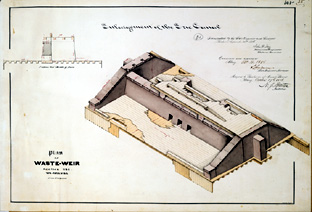

A waste weir provides a means of removing excess water from the canal, and provides a means of draining a section of the canal for repairs, for winter, or in anticipation of flooding. Because rising canal waters could overflow the banks, eroding them and causing a break in the canal, waste weirs were an important safety feature of early canals. Waste weirs were often located near feeders that might carry flood waters into the canal, and they often emptied into existing streams.
This waste weir was located in the town of Sweden, near Brockport. Similar to a dam, the central section of this waste weir is a three-part spillway with a towpath running above it. The stonework is indicated in purple. The two large stone trapezoidal buttresses on either end give stability to the central structure. The yellow planking that runs across the top carries the towpath over the weir (though it is not drawn all the way across in this diagram).
The canal water (not drawn) would lie to the right of the structure. When the water rose too high, it flowed under the towpath planking and over the spillway, falling onto the wooden apron below.
In the center bottom of the structure, beneath where the water falls over the spillway, are
three square holes which form sluices. Behind these sluices, and not visible in this drawing, are
three gates which can be opened to let water directly out of the canal. The low railing on the
towpath enables the towrope to slide over three rods which protrude above the level of the
towpath.
 These rods, turned by a large handle or wrench, drop down to open and close the sluice gates at
the bottom of the waste weir. The small drawing at the upper left of the waste-weir plan shows
one of these rods running vertically along the right edge of the stone structure.
These rods, turned by a large handle or wrench, drop down to open and close the sluice gates at
the bottom of the waste weir. The small drawing at the upper left of the waste-weir plan shows
one of these rods running vertically along the right edge of the stone structure.
At the end of the wooden apron is a row of sheet piling driven deep into the ground. This prevents fast-running water from hollowing out the gravel underneath the wooden apron and underneath the stone abutments of the weir -- a major problem for stone weirs and dams.
The waste weir gate lets water out of the waste weir in order to drain the canal. This heavily-braced structure had square valves at the bottom which were opened and closed by a handle at the top of the weir. The valves were connected to the handle by a rod and opened by pivoting when the handle was turned. The valve at the left side of the drawing to the right is in the closed position; the adjacent valve is in the open position.
http://www.eriecanal.org/UnionCollege/The_Waste_Weir.html